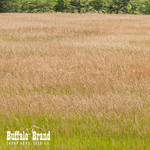Sold by the BULK pound
Botanical Name: Bromus inermis
Cultivars: Lincoln, Manchar, VNS
Smooth Brome, Bromus inermis is a major, cool-season, long-lived, perennial, sod-forming grass which reproduces from seed and spreads by creeping rhizomes. A native grass of Europe and Asia, Brome was introduced into the U.S. in the 1880’s. (USDA Plant Fact Sheet)
Lincoln is a southern type of Smooth Brome. This cool-season grass provides an abundance of early spring pasturage and fall regrowth. Lincoln is relatively easy to establish, and is often used for conservation purposes, especially erosion control around waterways.
Manchar is an intermediate strain between the northern and southern types of Smooth Brome. It is a mild sod-forming grass that is used on well drained soils. Manchar is often used in combination with certain legumes such as alfalfa, for hay, pasture, and silage.
- Grows erect with seed heads 6 to 8 inches long.
- Strong root systems form a coarse, dense sod which resists tramping, affords abundant grazing and serves as an anchor for soil when faced with wind and water erosion.
- It has a leafy spring growth that is both palatable and nutritious for livestock.
- There are two identifiable types: Northern Smooth Brome which is adapted to western Canada and northern Great Plains, and Southern Smooth Brome which is adapted to the Corn Belt States and central Great Plains.
Height:12-36 in
Spread:12-18 in
USDA Hardiness Zone: 4-7
Uses
Livestock: Smooth brome may be used for hay, pasture, or silage. It is compatible with alfalfa or other adapted legumes. The grass is highly palatable and is high in protein content and relatively low in crude-fiber content.
Erosion Control: Since the plant has a massive root system and is a sod former it can be used effectively for critical area planting and grassed waterways if the areas can be irrigated or where annual precipitation exceeds 20 inches.
Wildlife: Smooth brome can be used as a component in various upland wildlife and conservation cover mixes for nesting cover and food.
Note: This species is no longer recommended for wildlife use in some states because of its aggressive nature. Status Please consult the PLANTS Web site and your State Department of Natural Resources for this plant’s current status (e.g. threatened or endangered species, state noxious status, and wetland indicator values). This plant has threatened status in Michigan.
Weediness This plant may become weedy or invasive in some regions or habitats and may displace desirable vegetation if not properly managed. Please consult with your local NRCS Field Office, Cooperative Extension Service office, or state natural resource or agriculture department regarding its status and use. Weed information is also available from the PLANTS Web site at plants.usda.gov.
Adaptation and Distribution
Smooth brome is best adapted to cooler climates and is generally hardier than tall fescue or orchardgrass. It is resistant to drought and extremes in temperature. This plant is very susceptible to disease in areas of high humidity. Smooth brome grows best on slightly acid to slightly alkaline well drained clay loam soils with high fertility but it will also grow well on lighter textured soils where adequate moisture and fertility are maintained. Smooth brome performs best in a pH range of 6.0 to 7.5. Stands are difficult to obtain and growth is poor on soils high in soluble salts. Smooth brome is distributed throughout most of the United States. For a current distribution map, please consult the Plant Profile page for this species on the PLANTS Website.
Establishment
A clean firm seedbed is needed. Due to the slow germination and establishment of smooth brome, spring seedings are especially preferred in the northern states. In southern areas, late summer seedings are a second option. Fall seedings should be made at least 6 weeks before a killing frost is expected. Seeding rates are typically 5-10 pounds per acre in mixtures, and about 15 pounds when seeded alone. When smooth brome is seeded in a mixture with alfalfa, the alternate row method will give the best results. For seed production plantings under irrigation, seed in rows 30 to 42 inches apart at a rate of 3 to 4 pounds per acre. Seedings should be drilled at a depth of 1/2 to 3/4 inch. If broadcast increase the seeding rate and cultipack after planting.
Management
Smooth brome requires heavy early spring and fall applications of nitrogen to maintain high yields in a pure stand. Mixtures with alfalfa will require less nitrogen but the alfalfa will usually need P205 each year to maintain vigor. Alfalfa cannot be maintained in pasture seedings without rotation. Best forage production is obtained from smooth brome when used in a planned cropping system and plowed out after 3 to 4 years. Its heavy sod makes it an excellent soil conditioning crop when included in cropping systems. In deep, well-drained soils it will root to 4 feet.
Smooth brome performs best in grassed waterways, field borders, and other conservation uses where the forage can be cut and removed while in early bloom. Do not graze the new seeding; cut the first crop for hay.
Since Brome has a fairly short grazing season (early spring and early fall), usage should be controlled to avoid over-grazing. Soils should be tested and nitrogen levels kept high. Yields drop off when the fertility of the soil drops. Brome should be planted in early spring or fall; a firm, moist seed bed is needed for planting. Remember, no matter how strong and viable you stand of Smooth Brome may be, it can be easily ruined by over-grazing!!
In bromegrass-legume pastures, allow the legume to go to bud or early-bloom stage before turning cattle in to avoid bloat hazard, and manage thereafter for optimum regrowth of the legume. Pastures should not be grazed prior to smooth brome attaining a minimum height of about 10 inches at the beginning of the grazing season. Grazing pressures should be adjusted throughout the season to avoid grazing this grass to less than a minimum height of 4 inches. Grazing schedules should be so arranged that a regrowth period of 28 to 35 days between grazing periods is available. Pests and Potential Problems Grasshoppers and seedling blight are influences that may impede establishment. Foliar diseases are more common in humid areas and seasons. The bromegrass seed midge, Stenodiplosi
Growing & Maintenance Tips
Proper ground preparation is one of the most important consideration when native grasses are being established. The seed bed should be firm but not solid; cultivation to kill the roots of cool-season grasses is essential. Planting can be done by either drilling or broadcasting, and the seed should be covered with no more than one fourth inch of soil. Avoid planting the seed too deep. Test the soil for deficiencies and apply needed phosphorus, potassium or lime prior to seeding. No additional fertilization is required after the stand has been established. Once the stand is well established, regulate the grazing patterns to avoid over-grazing. This should be particular note toward the end of the growing season as grass grazed too closely weakens the root structure which holds the food supply through winter. Competing woody shrubs, undesirable weds and extensive mulch build-up can be managed by a controlled burn done in the late winter before the vegetation has begun its spring growth. Always check with an expert in grass management, such as our personnel at Sharp Brothers Seed Company before attempting such a burn for advice as to the proper technique to be used. Our personnel are trained to listen to your needs, help develop your program for planting and suggest suitable varieties for your location. With planning the preparation, your stand of Side-Oats Grama will supply you with dependable, warm-season forage crop for years to come.







